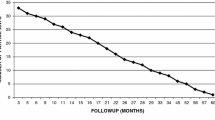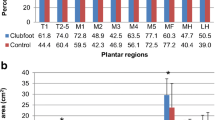Abstract
Gait patterns in children with recurrent clubfoot are often associated with more or less subtle factors contributing to the patterns, such as tibial torsion that might not be detected by visual observation and therefore not considered in a treatment plan. We therefore used gait analysis to elucidate the contributions to recurrent clubfoot deformity and to determine whether gait analysis could be important in preoperative decision-making for these patients. We reviewed all 35 patients (56 feet) referred to our gait laboratory for recurrent deformity following treatment of idiopathic clubfoot. The average age of the children in our series was 6.7 years (range, 3.6–15.4 years). Data were acquired from computerized motion analysis, dynamic electromyography, and static measurements by a physical therapist. We found a high incidence of transverse plane deformities including intoeing in 45 of 56 feet (80%), internal tibial torsion in 40 of 56 feet (71%), and forefoot adductus in 40 of 56 feet (71%). Forty feet were supinated in stance; of these patients, 28 (70%) had overactive tibialis anterior muscle activity based on dynamic EMG. Dynamic compensatory hip external rotation was present in 28 of 56 (50%) of limbs. Thirty of the 35 patients underwent surgery following gait analysis; the most common procedures included split anterior tibial tendon transfers (34), tibial derotational osteotomies (34), and midfoot osteotomies (20). Quantitative gait analysis resulted in 28 changed procedures in 19 of 30 patients (63%) compared to prestudy surgical plans.
Level of Evidence: Level IV, therapeutic study. See the Guidelines for Authors for a complete description of levels of evidence.



Similar content being viewed by others
References
Alkjaer T, Pedersen EG, Simonsen EB. Evaluation of walking patterns in clubfoot patients who received early intensive treatment. J Pediatr Orthop. 2000;20:642–647.
Asperheim M, Moore C, Carroll NC, Dias L. Evaluation of residual clubfoot deformities using gait analysis. J Pediatr Orthop B. 1995;4:49–54.
Beyaert C, Haumont T, Paysant J, Lascombes P, Andres JM. The effect of inturning of the foot on knee kinematics and kinetics in children with treated idiopathic clubfoot. Clin Biomech. 2003;18:670–676.
Davies T, Kiefer G, Zernicke RF. Kinematics and kinetics of the hip, knee, and ankle of children with clubfoot after posteromedial release. J Pediatr Orthop. 2001;21:366–371.
Dobbs MB, Nunley R, Schoenecker PL. Long-term follow-up of patients with clubfeet treated with extensive soft-tissue release. J Bone Joint Surg Am. 2006;88:986–996.
Haf GF, Walker CG, Crawford HA. Early clubfoot recurrence after use of the Ponseti method in a New Zealand population. J Bone Joint Surg Am. 2007;89:487–493.
Karol LA, O’Brien SE, Wilson H, Johnston CE, Richards BS. Gait analysis in children with severe clubfeet: early results of physiotherapy versus surgical release. J Pediatr Orthop. 2005;25:236–240.
Morcuende JA, Dolan LA, Dietz FR, Poneti IV. Radical reduction in the rate of extensive corrective surgery for clubfoot using the Ponseti method. Pediatrics. 2004;113:376–380.
Muratli H, Dali C, Yavuzer G, Celebi L, Bicimoglu A. Gait characteristics of patients with bilateral clubfeet following posteromedial release procedure. J Pediatr Orthop B. 2005;14:206–211.
Ponseti I. The relapsing clubfoot: causes, prevention, and treatment. Iowa Orthop J. 2002;22:55–57.
Theologis T, Harrington ME, Thompson N, Benson MK. Dynamic foot movement in children treated for congenital talipes equinovarus. J Bone Joint Surg Br. 2003;85:572–577.
Yngve D. Foot-progression angle in clubfeet. J Pediatr Orthop. 1990;10:467–472.
Acknowledgments
We thank Bitte S. Healy, MS PT, and Sandra W. Dennis, MS PT, for their valuable assistance with data collection and interpretation of gait analysis data for the subjects in this study.
Author information
Authors and Affiliations
Corresponding author
Additional information
Each author certifies that he or she has no commercial associations (eg, consultancies, stock ownership, equity interest, patent/licensing arrangements, etc) that might pose a conflict of interest in connection with the submitted article.
Each author certifies that his or her institution has approved the human protocol for this investigation and that all investigations were conducted in conformity with ethical principles of research, and that informed consent for participation in the study was obtained.
Electronic supplementary material
Below is the link to the electronic supplementary material.
About this article
Cite this article
Sankar, W.N., Rethlefsen, S.A., Weiss, J. et al. The Recurrent Clubfoot: Can Gait Analysis Help Us Make Better Preoperative Decisions?. Clin Orthop Relat Res 467, 1214–1222 (2009). https://doi.org/10.1007/s11999-008-0665-x
Received:
Accepted:
Published:
Issue Date:
DOI: https://doi.org/10.1007/s11999-008-0665-x




